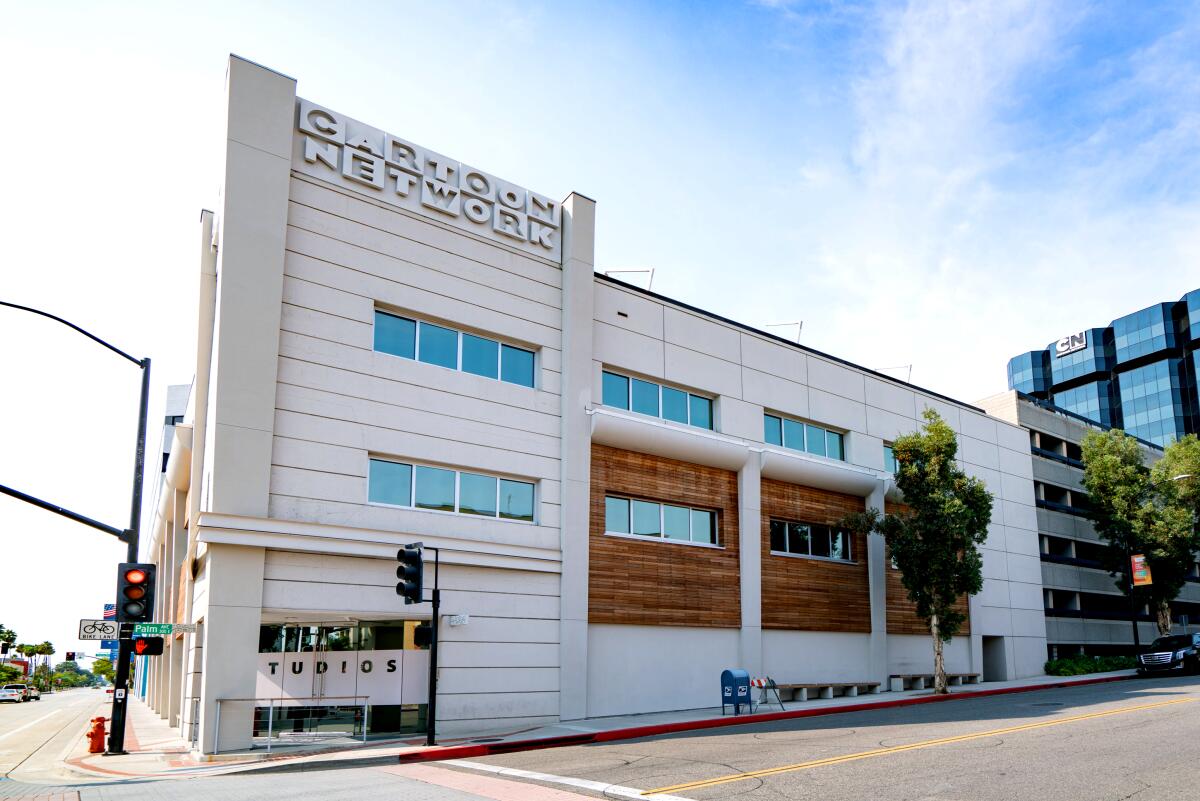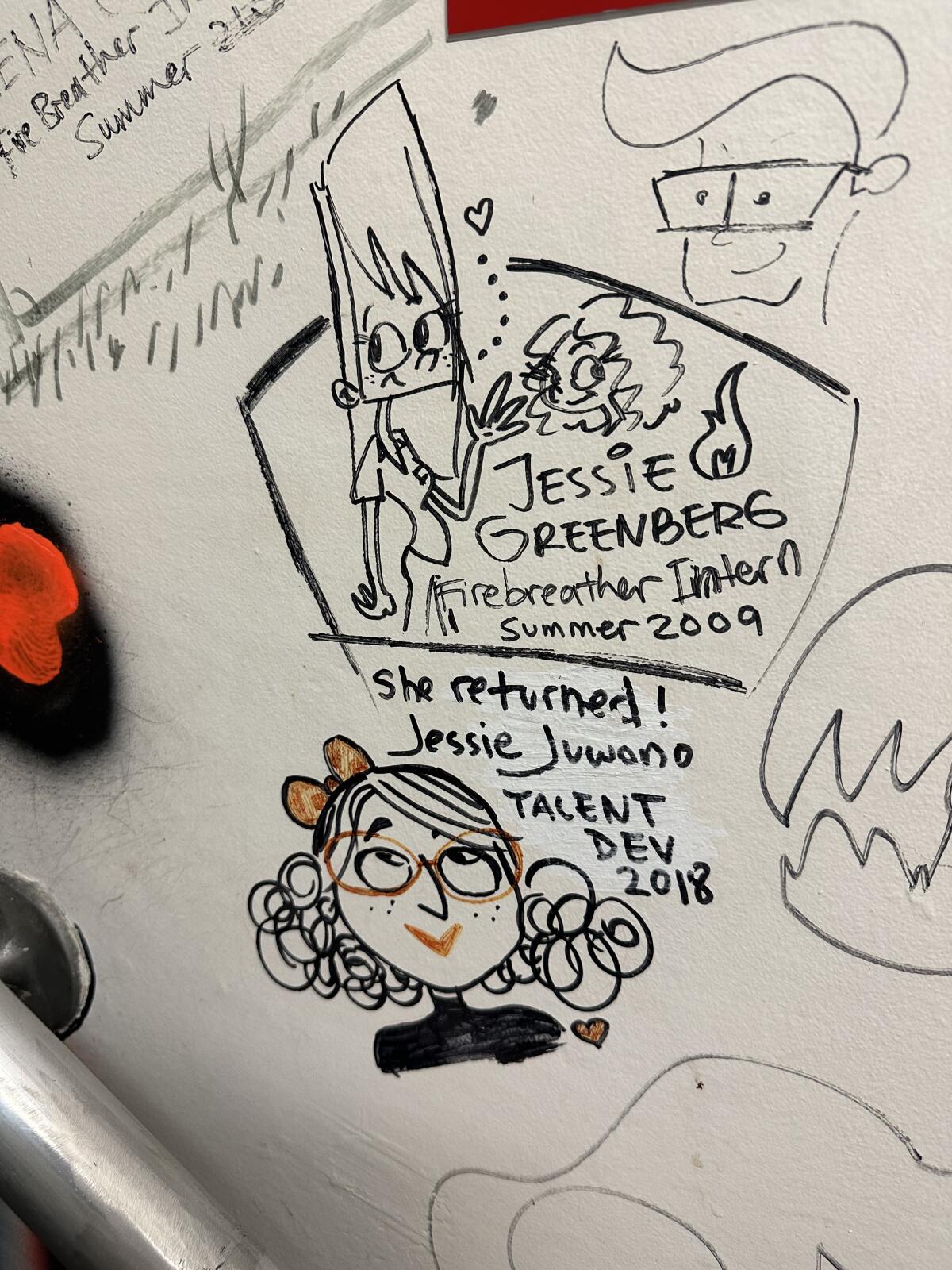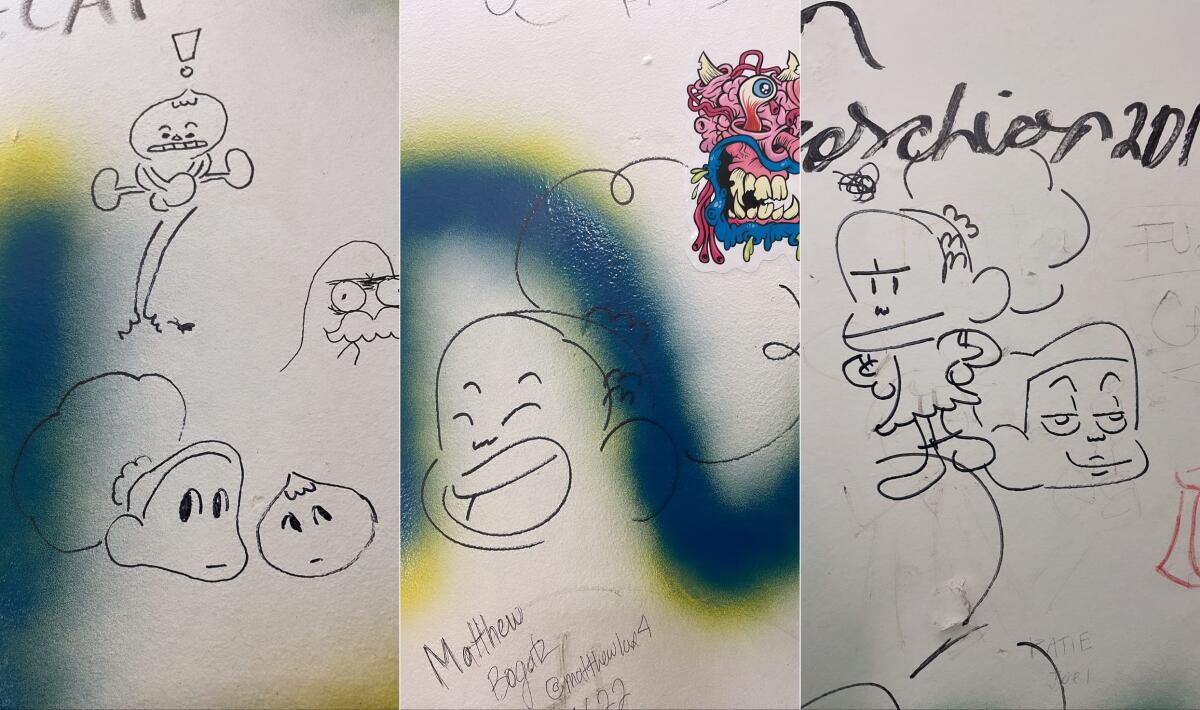When Calvin Wong learned that Cartoon Network Studios would be moving out of its longtime home in Burbank last year, he was overwhelmed by sadness.
The storied building was the launching point for numerous animated favorites over the years, including “Samurai Jack,” “Foster’s Home for Imaginary Friends,” “Adventure Time” and more. It was also where Wong started his first animation job years ago as a storyboard revisionist on “Regular Show.”
But what most concerned the “We Baby Bears” showrunner was the fate of a stairwell he walked by every day on the way to his office. Since opening its doors in 2000, the studio had given its staff free rein to draw on the walls in one of the building’s stairwells. More than 20 years worth of memories, milestones and inside jokes were etched on those walls by the people who walked through the building.
“Imagining someone with a paint roller painting over those walls just made me really sad,” said Wong during a recent video call. “It made me sad that the history of it — warts and all — would be painted over. I think that’s what ultimately made me want to preserve it. [But] I wasn’t sure how we were going to do it.”
“We Baby Bears” showrunner Calvin Wong drew a self-portrait in the former Cartoon Network Studios building’s artist stairwell.
(Cartoon Network Studios)
On Monday, Cartoon Network Studios launched its website commemorating this artist stairwell. For the first time ever, the general public can get a detailed look and take a virtual tour of the space as it was before the art was removed. In addition to a 3D walkthrough, the website includes snapshots and anecdotes from current and former staffers who left their marks on those walls.
Wong, who helped spearhead the preservation efforts, hopes the website will encourage more people to share their stories.
For “The Powerpuff Girls” creator Craig McCracken, the former Cartoon Network Studios building was a special place.
“I literally helped pick the building,” said McCracken, explaining that former Cartoon Network executives Mike Lazzo and Rob Sorcher had shared their early plans for a studio with him and “Dexter’s Laboratory” creator Genndy Tartakovsky. “We knew for, like, two years that they were going to get us a studio, but we weren’t allowed to say anything.“
After being shown a few options in Burbank, McCracken and Tartakovsky helped pick the location on the corner of Third Street and Palm Avenue that, according to reports at the time, was a former Pacific Bell building. They even provided input for the design of the artists’ workspaces. (“Everyone assumes that animators like big wacky shapes and lots of colors and things like that, but we want neutral, organic, wood,” said McCracken.)

When Cartoon Network Studios left its longtime Burbank home, it had to leave some animation history behind.
(AaronP/Bauer-Griffin/GC via Getty Images)
As soon as the studio was officially open, the artists were given cans of spray paint and told they were free to write and draw in the four-story stairwell.
“It was really a place for creative experimentation and creative freedom,” said McCracken. “[The executives] really valued and appreciated the artists and the stairwell was sort of their way of saying, ‘This is yours.’ So every day, when you would be going up between the floors, you were reminded of the freedom we had here at Cartoon Network.”
Only the earliest graffiti was done in spray paint, however. For health and safety reasons the artists were quickly told that they had to switch to pens or pencils. Over the years, the walls have been filled in with self-portraits, drawing of characters from various shows and even messages responding to notes left years prior.
Jessie Juwono, who works on the studio’s artist management team, first walked through the Cartoon Network Studios doors as a production intern in 2009.
“The stairwell felt really magical, especially when you came in as an intern,” said Juwono, who noted the creativity “felt electric.”

Cartoon Network Studios staffer Jessie Juwono’s drawings in the artist stairwell.
(Cartoon Network Studios)
Juwono commemorated her time as an intern with a drawing of a character she created in the stairwell. Years later, when she returned to the studio as a staffer, she added another piece right next to it.
“It was a cool full circle moment,” said Juwono. “I decided to sign it again right under my old drawing to have it be like ‘and all these years later, she came back and she had this new title and new name and the same love for animation.’“
Wong remembers feeling a bit overwhelmed and intimidated by the history it represented when he walked into the artist stairwell for the first time, but what he appreciates is that “the wall was very democratic.”
“Anybody could draw on it,” said Wong. “So you’d have some legendary sketches but, a [visiting] little kid would draw right next to it.”
For Wong, that was a reflection of Cartoon Network Studios’ ethos, where the creative voices of everyone at every level were valued.
“It was a place that was really open to any ideas,” said Wong. “Anybody could come pitch something. We put creators first, no matter how you drew or where you came from.”
Nick Winn, a prop and character designer on shows like “Craig of the Creek” and “Jessica’s Big Little World,” describes the artist stairwell as a museum and “a time machine.”

Nick Winn made sure to draw some characters from “Jessica’s Big Little World” before he left the building.
(Cartoon Network Studios)
“The stairwell shows the times and how styles have changed throughout the years,” said Winn. “Seeing drawings from people like Craig McCracken, [the] ‘Steven Universe’ [crew] … as someone who’s grown up with Cartoon Network, it all was really breathtaking to me.”
Although Winn liked to take in the art in the stairwell, it wasn’t until after “Jessica’s Big Little World” wrapped that he added drawings of his own along with other members of the crew.
“I kept forgetting to draw in the stairwell,” said Winn. “When the last day hit, I was determined to draw in that stairwell before I left.”
Occasionally the memories commemorated within the stairwell were bittersweet. Wong remembers the staffers of “Driftwood” adding “all these beautiful drawings from that project” on the walls on the day they’d learned their animated film was suddenly canceled.
While Cartoon Network Studios continues to exist, since the Warner Bros. Discovery merger in 2022, its production and development teams were consolidated with Warner Bros. Animation’s. After vacating their former building, the studio’s current staff have moved into the Frank Gehry-designed iceburg-like office buildings near the Warner Bros. lot. (Their new space is decorated with mementos of the old Cartoon Network Studios building, including wallpaper based on the artists stairwell.)
“Cartoon Network really cared about their artists in a way that wasn’t just [about] mak[ing] a cartoon so we can make some money,” said Winn.
For some of the artists, the shuttering of the building marked an end of an era — especially as the animation industry had been deeply affected by streamers trying to course-correct on their lavish overspending even before Hollywood’s recent contraction. Others remain optimistic that Cartoon Network Studios will retain what made it special for them.
Although Juwono was sad about the studio vacating its storied building, she notes that in animation, “things are always changing and that’s not necessarily a bad thing.”
“No matter what building we’re in, I think we’ll always have this creative spirit that can’t be contained,” said Juwono.
McCracken echoed her sentiment.
“Seeing [the building] shut down was sad, but it’s not really the place, it’s the people,” he said. “The spirit of Cartoon Network still exists among the artists in the community. But that place was special and the stairwell, especially, was special.”


